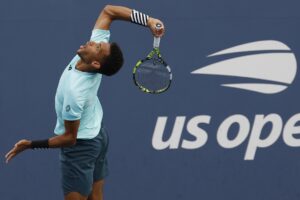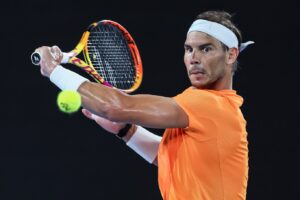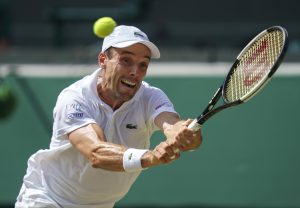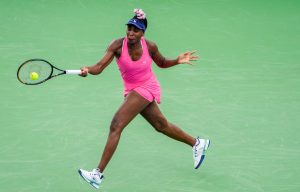11 years ago, in Melbourne, two young players built the beginnings of their reputation. One was Jo-Wilfried Tsonga. His flamboyant attacking tennis was to take him to victories over Andy Murray–who would reach the US Open final later that year–in the first round, and Rafael Nadal–who would finish the year as World #1 after completing the “Channel Slam” by winning the French Open and Wimbledon–in the semifinals. He was explosive and fun.
The other was Novak Djokovic. His tennis was not cut from the same attacking cloth as Tsonga’s. His style was precise, clinical. Nor had he burst from almost total obscurity to instant stardom. In 2007, he’d won in Miami and Toronto and reached the final in New York, losing in straight sets to Roger Federer. He was to have his revenge on the Swiss in Melbourne, beating the World #1 and two-time defending champion in the semifinals in straight sets.
When the two young stars met in the final, the crowd was with Tsonga almost to a man. He came out firing, swinging freely and driving Djokovic back. The Serbian did his best to withstand Tsonga’s assault but the pressure eventually told in as Tsonga broke late to take the first set 6-4. But from there, Djokovic only redoubled his efforts, conjuring a storm of his own. He leveled the match in the second, wresting back control of its destiny. Then Djokovic broke twice to win the crucial third set, despite Tsonga saving six set points.
Tsonga’s position was looking increasingly bleak. He was not yet down on the canvas, but he was certainly on the ropes. Djokovic and his pockets of supporters inside Rod Laver Arena were ascendant. And even those in the crowd who weren’t with the Serbian seemed to be aiding him, as he created a siege mentality to further sharpen his focus. The Tsonga charge seemed to have at last been decisively halted.
But for all that Djokovic pressed for the killer blow, he could not find it. Tsonga found his streak of defiance and held off the Serbian. Until, in the eleventh game of the set, his chance arrived. He forced a break point and Djokovic seemed rattled. The crowd disrupted his serve. Djokovic found a first serve anyway. Tsonga flung out his racquet to get it back and Djokovic hit a heavy-handed drop shot. But Tsonga, with the court at his mercy, hit his forehand back to Djokovic, who put away a volley.
Djokovic walked back to the service line nodding in satisfaction. Tsonga’s chance had come and gone. Djokovic held serve and though the Frenchman forced a tiebreak, Djokovic dominated it, winning his maiden Major as Tsonga sent a forehand into the tram lines. The Australian Open was his. His ascent was far from complete and he would return to the chasing pack for the next two years, as Federer and Nadal reasserted their dominance.
Then in 2011, he put together a historic year. He won three of the four Slams, five Masters titles, began the year with a 41-match winning streak and established himself as a force in the game to equal Federer and Nadal. Indeed, for a time, he surpassed them, even completing the strangely unheralded feat of winning all four Major titles in a row between 2015 and 2016. Regardless, his position as one of the greats of the game is beyond doubt and he reigns once more atop the world rankings.
For Tsonga there was to be no Grand Slam glory. He never managed to recapture the Melbourne magic of 2008, though he came close at times. Beloved by the Roland Garros crowds, he reached two French Open semifinals, but lost them to David Ferrer and Stan Wawrinka. He had his moments at the All-England Club to; beating Federer from two sets down in 2011 to make the last four and repeating the feat a year later in another thrilling run. But Novak Djokovic and Andy Murray halted his challenges, Tsonga’s attack was blunted in the face of their defensive abilities.
At his best, he was devastatingly good, with his swashbuckling tennis reminding crowds of the legend he had threatened to build at the Australian Open. On those days, even the greats suffered at his hands. But they became rarer and rarer. Whilst his peers improved relentlessly just to keep pace with the titanic figures at the top of the sport, weaknesses began to appear in Tsonga’s game. His backhand broke down. His serve or forehand or both abandoned him from time to time. And the results went with them.
For Djokovic, 2008 was the beginning of one of the most remarkable careers in the history of men’s tennis. In perhaps the most competitive era ever, confronted by two players of astonishing quality, Djokovic, through sheer force of will and unblinking belief in his own talent, has carved out a pre-eminent place in the history of the sport. But Tsonga, a shimmering, ephemeral figure lost in the churning and changing pack of challengers, is ultimately to be forgotten.
Unless of course, the Tsonga of 2008 re-emerges from the through the mists of time to stun Djokovic in 2019. That would be a story well worth remembering.
Main Photo:
Embed from Getty Images






